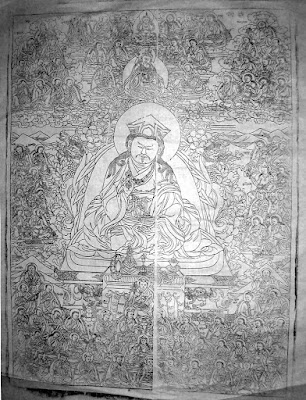 |
| click to enlarge |
Recognize anyone here? The photo is low resolution, for this I apologize. I saved it years ago from a website that doesn’t seem to exist anymore. Despite this lack of clarity, it is possible to perceive beneath the throne lion just beneath the large central figure, and on your right, a rectangular cartouche bearing his name. I think I can make out “Mchog-gyur-bde-chen-gling-pa,” one of the many forms used as names of Chogyur Lingpa (མཆོག་གྱུར་གླིང་པ་), birth in 1829, death in 1870. He was probably the most prolific all-time treasure revealer in Tibetan history, and a great inspiration for what we have, with some degree of justice, often called the Rimé Movement. In one of the several portrait paintings locatable at HAR website that feature him as chief figure, there is one that corresponds quite nicely and precisely enough with this one, and that should be enough to confirm our intuitions are correct and we’ve made the right identification. This thangka painting is doubly blessed for having prints of both hands of the master done in vermillion ink on its reverse side.
 |
| Go here to see the full painting in all its details |
But then who are all those other smaller figures surrounding him in the woodblock print? I think that’s easily answered. With the exception of the two figures directly above the central figure’s head, all the others ought to form one group. I haven’t tried counting them, but I could wager they would add up around one hundred, or one hundred and eight. I argue it must be the collectivity known as Tertön Hundred (གཏེར་སྟོན་བརྒྱ་རྩ་). Furthermore, it must be the same precise group of tertöns found in a collective biography of the same by Jamgön Kongtrul Rinpoche (འཇམ་མགོན་ཀོང་སྤྲུལ་རིན་པོ་ཆེ་), himself a disciple of Chogyur Lingpa. But it would be great to be able to see a better photo so that all the individually labeled figures could be exactly identified. My eyesight isn’t up to the task.
That there exists such a remarkable collective icon of the Tertöns would be a thing worthy of knowing. These woodblock prints often served as patterns for thangkas, although I haven’t seen a painted example yet. It ought to be compared to the rather old mural paintings in an upper room in the main temple of Mindroling Monastery I once had the fortune to see with my own eyes even if the room was a little too dark. I’d love to see them again. If you know of published illustrations, please type a comment in the comment box. Or if you have anything else to say, we’d love to hear it.
Sources:
To the best of my knowledge the woodblock print was once posted at a website that might have belonged to Derge Monastery (སྡེ་དགེ་དགོན་པ་) itself. I will try to find out more.
A web search did lead me to one thangka depicting over a hundred tertöns. Try going to this "tinyurl."
For fundamental information on Chogyur Lingpa, see the biographical entry “Chokgyur Dechen Lingpa” at rigpawiki.org, which includes a very nice painting, as well as the entry “Chokgyur Lingpa” by Alexander Gardner that is part of Treasury of Lives website. Andreas Doctor, The Tibetan Treasure Literature: A Study of the Revelations of the Visionary Master Mchog gyur bde chen gling pa (1829-1870), doctoral dissertation, University of Calgary (2003). This became a book with the title Tibetan Treasure Literature: Revelation, Tradition, and Accomplishment in Visionary Buddhism, Shambhala Publications (Boulder 2005). We can also recommend Urgyen Topgyal, The Life and Teachings of Chokgyur Lingpa, Rangjung Yeshe Publications (Kathmandu 1988). And finally, go to Lotsawa House for this page full of links to works either by Chogyur Lingpa or in some other way connected with his name, most of them made freely available in English.
Here is all the literature I know about with English translations from Jamgön Kongtrul’s Tertön Hundred biographies: A full translation by Yeshe Gyamtsho was published under the title The Hundred Tertöns, KTD Publications (Woodstock 2011). Some parts have been translated in Eva M. Dargyay, The Rise of Esoteric Buddhism in Tibet, Motilal Banarsidass (Delhi 1979). See also the bits translated in Ramon Prats, “Some Preliminary Considerations Arising from a Biographical Study of the Early Gter-ston,” contained in: Michael Aris and Aung San Suu Kyi, eds., Tibetan Studies in Honour of Hugh Richardson, Aris and Phillips, Ltd. (Warminster 1980), pp. 256-260. Also, this: Ramon Prats, Contributo allo studio biografico dei primi gter ston (Naples 1982). We’ve explored some of the prehistory of Kongtrul’s Tertön Hundred in a three-year-old blog, “Locating a Tertön Prayer in Terma History.” Something there may prove of use if you want to delve into the history of terma studies.
If, on the other hand, you need a fast and relatively easy introduction to Tertöns and Termas, see this short essay by Karma Phuntso entitled “Terma and Tertön: Revealed Teachings and Their Revealers.”
§ § §
PS (March 13, 2023):
I did a little creative web searching and at long last landed on the relaunched (since 2019) version of the Derge Printery website: http://www.degeparkhang.org.
It does in fact have the Chokgyur Lingpa woodblock, but even more impressively, it has a 2nd one of the Tertön Hundred with a different central figure, none other than the author of the most famous collection of Tertön biographies, Jamgön Kongtrul. For both, go first to this page, then download them one at a time.

